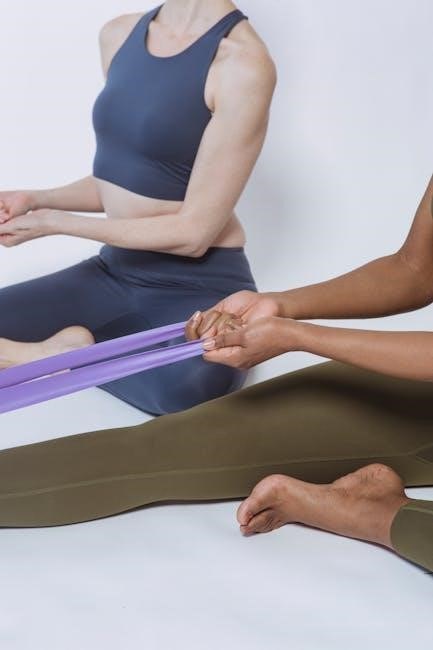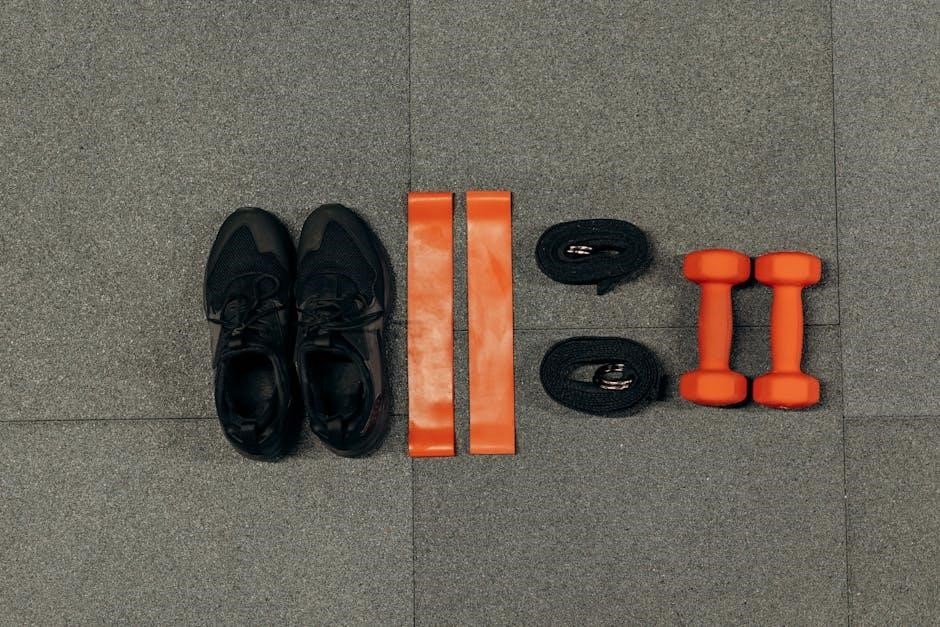Welcome to the efficient world of 15-minute resistance band workouts, perfect for busy schedules. Engage your full body with minimal equipment and achieve fitness goals anywhere, anytime. Stay consistent for the best results!
Why Resistance Bands Are Ideal for Quick Workouts
Resistance bands are perfect for quick workouts due to their portability, affordability, and versatility. They provide continuous tension, engaging muscles effectively without bulky equipment. Ideal for all fitness levels, bands offer adjustable resistance, making them suitable for beginners and advanced users alike. Their compact design allows workouts anywhere, saving time and space. With a focus on full-body engagement, bands enable efficient, time-saving sessions like a 15-minute resistance band workout. They’re a practical solution for busy schedules, delivering impactful results without requiring a gym. This convenience makes them a favorite for those seeking fast, effective training on the go.
Benefits of a 15-Minute Full-Body Workout
A 15-minute full-body workout with resistance bands offers numerous benefits, including time efficiency and comprehensive muscle engagement. It improves cardiovascular health, boosts metabolism, and enhances strength without requiring lengthy gym sessions. The portability of bands allows workouts anywhere, making it ideal for busy schedules. This format also promotes consistency, as short sessions are easier to maintain. Additionally, it targets multiple muscle groups simultaneously, improving coordination and posture. The combination of strength and cardio elements burns calories effectively, even after the workout ends. This concise yet impactful routine is perfect for those seeking balanced fitness in minimal time, while also reducing stress and energizing the body. Consistency yields noticeable results, making it a sustainable choice for long-term wellness.

Understanding Resistance Bands
Resistance bands are versatile, portable tools offering effective strength training. They provide continuous tension, engaging muscles throughout exercises. Ideal for all fitness levels, they’re affordable and easy to use anywhere.
Types of Resistance Bands Available
Resistance bands come in various styles, catering to different fitness needs. Loop bands are ideal for full-body workouts, offering consistent tension. Tube bands with handles provide better grip and control, suitable for upper body exercises. Mini bands are perfect for targeting smaller muscle groups like glutes and legs. Therapy bands are lightweight, designed for rehabilitation. Lastly, stackable bands allow users to increase resistance by layering multiple bands. Each type offers unique benefits, making them versatile tools for any workout routine.
How to Choose the Right Resistance Level
Selecting the right resistance level is crucial for an effective workout. Start with lighter bands to focus on form and endurance, then gradually move to heavier ones as you build strength. Light resistance (10-20 lbs) is ideal for beginners or rehabilitation. Medium resistance (20-30 lbs) suits general fitness and muscle toning. Heavy resistance (30+ lbs) is best for advanced users aiming for muscle building. Choose based on your fitness goals and current strength level to maximize results and prevent injury.

Key Exercises for a 15-Minute Workout
Focus on efficient, full-body exercises like banded squats, chest presses, and seated rows. These moves target multiple muscle groups, ensuring a comprehensive workout in just 15 minutes.
Banded Squats for Lower Body Strength
Banded squats are a powerful exercise for building lower body strength. Place the resistance band around your hips, ensuring it’s snug but not overly tight. Stand with feet shoulder-width apart, engage your core, and perform a squat, keeping your chest up and knees behind your toes. Push through your heels to return to a standing position. This exercise targets your glutes, quads, and hamstrings. For added intensity, pulse at the bottom or incorporate lateral movements. Adjust the band’s resistance based on your fitness level to maximize results and improve posture, balance, and overall lower body stability in just minutes.
Banded Chest Press for Upper Body
Strengthen your chest and shoulders with the banded chest press. Anchor the resistance band behind your back and hold the ends at shoulder height. Press the band forward, extending your arms fully, then return to the starting position. Keep your core engaged and maintain control throughout the movement. This exercise targets the pectoralis muscles while engaging the triceps and anterior deltoids. Adjust the band’s tension for desired resistance. Perform 12-15 reps for 3 sets to build upper body strength and improve posture. Perfect for a quick, effective workout that tones and sculpts your chest muscles in minutes.
Seated Rows for Back and Core
Target your back and core with the seated row. Sit on the floor with knees slightly bent, loop the resistance band around a sturdy object, and pull the band towards your chest. Keep your core engaged, shoulders down, and focus on squeezing your back muscles. Avoid rounding your shoulders or using momentum. This exercise strengthens the latissimus dorsi, rhomboids, and trapezius muscles. Perform 3 sets of 12-15 reps for a strong, defined back. Ideal for improving posture and enhancing rowing mechanics in a quick, 15-minute workout routine.
Banded Shoulder Press for Shoulder Strength
Strengthen your shoulders with the banded shoulder press. Stand with the resistance band under your feet, holding the ends at shoulder height. Press the band overhead, extending your arms fully, then lower back to the starting position. This exercise targets the deltoids and trapezius muscles, improving shoulder strength and stability. Perform 3 sets of 10-12 reps. Keep your core engaged and avoid arching your back. Incorporate this move into your 15-minute workout for a strong, sculpted upper body. It’s an effective alternative to dumbbells, perfect for home or travel workouts.
Banded Glute Bridges for Glute Activation
Lie on your back with knees bent and feet flat on the ground. Place a resistance band over your hips, holding the ends firmly. Engage your core and lift your hips, squeezing your glutes at the top. Lower slowly to the starting position. This exercise targets the glutes, hamstrings, and core, improving posterior chain strength and posture. Perform 3 sets of 12-15 reps. Keep the movement controlled to maximize glute activation. Incorporate this into your 15-minute workout for a strong, toned lower body. It’s an excellent move for targeting hard-to-reach muscles without heavy equipment.
Banded Leg Curls for Hamstring Development
Target your hamstrings with banded leg curls, an excellent exercise for strength and flexibility. Sit on the floor with your legs extended, looping the band around your ankles. Hold the band securely and curl your legs toward your glutes, keeping the movement controlled. Focus on squeezing your hamstrings at the top before slowly returning to the starting position. Perform 3 sets of 12-15 reps. This exercise strengthens the hamstrings and improves posterior chain function, essential for overall lower body stability and athleticism. Incorporate it into your 15-minute workout for a well-rounded routine.

Workout Structure and Timing
Divide your 15-minute session into 3-4 sets of 45 seconds of work and 15 seconds of rest. Focus on full-body exercises for maximum efficiency and portability.
How to Divide the 15 Minutes Effectively
Begin with a 2-minute warm-up to prepare your muscles. Dedicate 10 minutes to strength training, focusing on 3-4 exercises per set. Allow 1-2 minutes for a cool-down to stretch and recover. This structure ensures a balanced and efficient workout.
Importance of Warm-Up and Cool-Down
A proper warm-up prepares your muscles for exercise, reducing injury risk and improving performance. Spend 2-3 minutes on light movements like arm circles or leg swings. After your workout, a cool-down with stretching helps flexibility and reduces muscle tension. Incorporate deep breathing to lower heart rate and relax. Neglecting these steps can lead to soreness or strain. Consistency in warming up and cooling down ensures a safer, more effective workout routine. Make these phases a priority for long-term fitness success.

Progression and Variations
Gradually increase resistance and modify exercises to suit fitness levels. Incorporate cardio bursts for efficiency, ensuring varied and challenging workouts that promote continuous improvement and engagement.
How to Increase Resistance Over Time
To progressively increase resistance, start with lighter bands and gradually switch to thicker ones as strength improves. Incorporate multiple bands for added tension or use advanced techniques like double-looping. Focus on full-range movements to maximize tension throughout exercises. As you build muscle, introduce variations like paused reps or slower tempos to enhance challenge. Tracking progress in a workout journal can help monitor improvements and guide resistance adjustments efficiently. Remember, consistent overload is key to continuous strength gains in your 15-minute routine.
Modifying Exercises for Different Fitness Levels
Customize your 15-minute workout by adjusting resistance levels and exercise intensity. For beginners, use lighter bands and focus on proper form. Intermediate users can increase resistance or add pauses to movements. Advanced individuals can combine multiple bands or incorporate dynamic movements. Modify ranges of motion to suit mobility levels, ensuring safety and effectiveness. Progressions, like single-leg exercises or overhead presses, challenge even the fittest. Tailor each exercise to match your fitness level, ensuring a balanced and effective full-body workout that evolves with your strength and endurance.
Incorporating Cardio Bursts for Efficiency
Add cardio bursts to your 15-minute workout for enhanced calorie burn and cardiovascular benefits. Alternate between strength exercises and short, intense cardio segments like jump squats or band rows. Incorporate 30-second bursts of high knees or burpees between resistance exercises. This interval-style training boosts heart rate and maximizes efficiency. Use a timer to maintain structure, ensuring 50 seconds of work followed by 10 seconds of rest. This format keeps workouts dynamic and engaging, combining strength and cardio for a full-body challenge. Perfect for those seeking a time-efficient, comprehensive fitness routine that delivers results quickly and effectively.

Safety and Form
Always warm up before starting and maintain proper form to prevent injuries. Use controlled movements, avoid snapping bands, and ensure they are securely anchored. Listen to your body to avoid overexertion and adjust resistance as needed for safety and effectiveness. Proper form ensures a productive and injury-free workout experience.
Proper Form to Avoid Injury
Maintaining proper form is crucial to prevent injuries during resistance band workouts. Always engage your core and keep movements controlled. Avoid jerky or bouncy actions, as they can cause undue stress on muscles and joints. Ensure the bands are securely anchored or held firmly to prevent snapping. Start with slower, focused movements to build strength and confidence. Pay attention to your posture, keeping your spine neutral, especially during exercises like banded rows or shoulder presses. Proper form not only enhances the effectiveness of each exercise but also minimizes the risk of strain or injury, ensuring a safe and productive workout routine.
Listening to Your Body During the Workout
Listening to your body ensures a safe and effective workout. If you experience sharp pain or discomfort, stop immediately. Rest when needed and adjust resistance levels to suit your fitness level. Avoid pushing through fatigue, as it can lead to poor form and injury. Stay hydrated and monitor your breathing to maintain a steady pace. Be mindful of muscle tension and adjust your movements accordingly. By paying attention to your body’s signals, you can optimize your workout and achieve long-term progress without compromising your health or well-being.

Downloading and Using the PDF Guide
Access your 15-minute resistance band workout PDF guide for free. Print it to follow structured routines and track progress. Portable and easy to use, it ensures consistency in your workouts.
How to Access the 15-Minute Workout PDF
Accessing the 15-minute resistance band workout PDF is simple. Click the provided link to download the guide instantly. Ensure compatibility with your device for easy viewing. Print or save digitally for convenience. Follow the structured routine, which includes exercises, sets, and timing. Use the guide to track progress and stay motivated. This portable resource is perfect for home, travel, or gym use, helping you maintain consistency in your fitness journey. Make the most of your workouts with this comprehensive and user-friendly guide.
Printing and Using the Guide for Routine
Printing the 15-minute resistance band workout PDF allows easy reference during sessions. Laminate the pages for durability or keep them in a binder. Review the guide beforehand to understand exercises and timing. Track progress by noting reps and resistance levels used. Bring the guide to your workout space as a visual reminder of the routine. Consistency is key, so refer to it daily to stay on track. This structured approach ensures you maximize efficiency and maintain motivation, helping you achieve your fitness goals effectively.
A 15-minute resistance band workout is a powerful tool for achieving fitness goals efficiently. Stay consistent, track progress, and embrace the convenience of these portable exercises to maintain a healthy, active lifestyle.
Final Tips for Consistency and Success
Consistency is key to achieving results with resistance band workouts. Schedule your 15-minute sessions in advance to ensure they become a non-negotiable part of your daily routine. Start with lighter resistance and gradually increase as your strength improves. Always prioritize proper form to avoid injuries and maximize muscle engagement. Track your progress by noting completed workouts and resistance levels. Stay hydrated and listen to your body to avoid overexertion. Incorporate variety by rotating exercises and adding cardio bursts for enhanced efficiency. Most importantly, stay motivated by celebrating small victories and reminding yourself of your fitness goals. Success is within reach!
